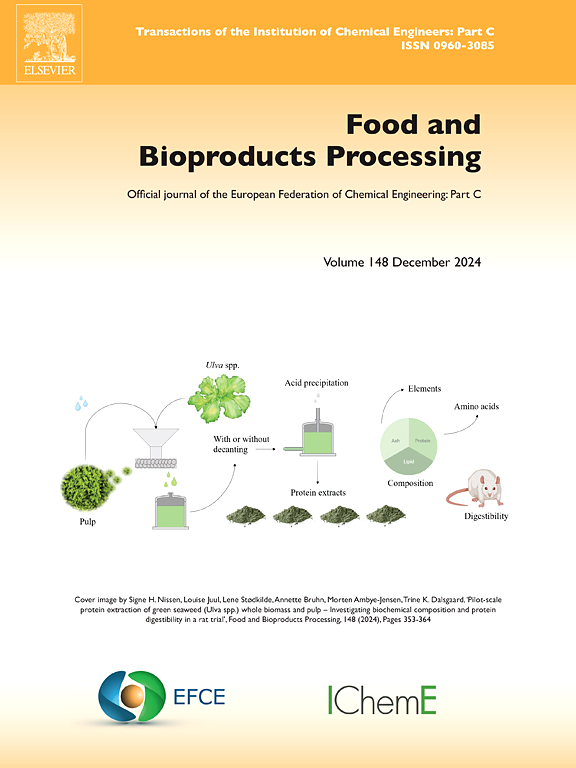改善双端口固态微波系统加热性能的扫频和互补相对相位组合策略
IF 3.4
2区 农林科学
Q2 BIOTECHNOLOGY & APPLIED MICROBIOLOGY
引用次数: 0
摘要
双端口固态微波加热可以解决单端口微波功率低的问题,并可能带来更好的微波加热性能。这项研究开发并评估了一种用于食品双端口微波加热的联合扫频& 互补相对移相加热策略。组合-扫描& 互补-相对相移策略首先有序地扫描两个端口之间的相对相位,从 0°到 315°,间隔 45°,工作频率为 2.45 GHz,每个端口的功率水平为 200 W,以确定与相对相位相关的热贡献。然后,确定了对实时加热结果具有互补热贡献的相对相位,并将其用于加热过程。将一盘 300 克的结冷胶模型食品微波 3 分钟的性能与固定相对相位策略和有序扫动相对相位策略进行了比较。结果表明,互补策略的加热均匀度(HUI = 0.27 ± 0.01)明显高于其他策略。在互补和有序扫描加热策略中,观察到了相似的微波功率吸收以及最高和最低温度,这优于固定加热策略。总的来说,互补策略的加热均匀性更好,其次是有序扫描策略,然后是固定相对移相加热策略。互补相对相移策略有望被纳入固态微波系统,用于智能加热过程。本文章由计算机程序翻译,如有差异,请以英文原文为准。
A combined-sweeping & complementary-relative-phase strategy to improve heating performance in a dual-port solid-state microwave system
Dual-port solid-state microwave heating could address the single-port low microwave power issue and potentially result in better microwave heating performance. This study developed and evaluated a combined-sweeping & complementary-relative-phase-shifting heating strategy for dual-port microwave heating of foods. The combined-sweeping & complementary-relative-phase-shifting strategy first orderly swept the relative phases between two ports from 0° to 315° at an interval of 45° operated at a frequency of 2.45 GHz and a power level of 200 W for each port to determine relative phase-dependent thermal contributions. Then, relative phases that have complementary thermal contributions to the real-time heating results were determined and used in the heating process. The performance of microwaving a tray of 300 g gellan gel model food for 3 minutes was compared with that of the fixed-relative-phase and orderly-sweeping-relative-phase strategies. The results showed that the complementary strategy delivered significantly more uniform heating results (HUI = 0.27 ± 0.01) than the other strategies. Similar microwave power absorption and maximum and minimum temperatures were observed in the complementary and orderly sweeping heating strategies, which was better than the fixed heating strategy. Overall, the complementary strategy showed superior heating uniformity, followed by the orderly sweeping and then the fixed-relative-phase heating strategy. The complementary relative phase shifting strategy is promising to be incorporated into solid-state microwave systems for smart heating processes.
求助全文
通过发布文献求助,成功后即可免费获取论文全文。
去求助
来源期刊

Food and Bioproducts Processing
工程技术-工程:化工
CiteScore
9.70
自引率
4.30%
发文量
115
审稿时长
24 days
期刊介绍:
Official Journal of the European Federation of Chemical Engineering:
Part C
FBP aims to be the principal international journal for publication of high quality, original papers in the branches of engineering and science dedicated to the safe processing of biological products. It is the only journal to exploit the synergy between biotechnology, bioprocessing and food engineering.
Papers showing how research results can be used in engineering design, and accounts of experimental or theoretical research work bringing new perspectives to established principles, highlighting unsolved problems or indicating directions for future research, are particularly welcome. Contributions that deal with new developments in equipment or processes and that can be given quantitative expression are encouraged. The journal is especially interested in papers that extend the boundaries of food and bioproducts processing.
The journal has a strong emphasis on the interface between engineering and food or bioproducts. Papers that are not likely to be published are those:
• Primarily concerned with food formulation
• That use experimental design techniques to obtain response surfaces but gain little insight from them
• That are empirical and ignore established mechanistic models, e.g., empirical drying curves
• That are primarily concerned about sensory evaluation and colour
• Concern the extraction, encapsulation and/or antioxidant activity of a specific biological material without providing insight that could be applied to a similar but different material,
• Containing only chemical analyses of biological materials.
 求助内容:
求助内容: 应助结果提醒方式:
应助结果提醒方式:


